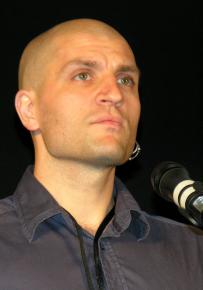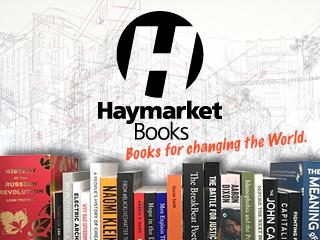A tale of two cities
reviews a good detective novel, with an even more interesting twist.
CHINA MIÉVILLE'S novel The City and the City is a departure from his proven area of mastery--science fiction/fantasy--which makes the critical praise and awards raining down on it all the more impressive.
Miéville's hard-boiled murder mystery won him a third Arthur C. Clarke prize (he's the first three-time winner), plus finalist nominations for the Hugo and Nebula Awards. That plus the release of a paperback edition of the novel last month is my excuse for finishing the review I promised to write last summer and, ahem, didn't.
But I'm in time for this summer, and I'll unreservedly recommend The City and the City for your list of books to bring to the beach. All the more so for us socialists. China Miéville is one of us, a member of Britain's Socialist Workers Party and author of a Marxist analysis of international law from Haymarket Books.
It shows in The City and the City. Woven into the fabric of a tightly written detective story is the questioning of a basic aspect of life in a capitalist society, one that goes unacknowledged and unexamined for most people, most of the time.

The novel is set in the city-state of Beszel, a small country somewhere on the economic margins of Europe, with its best days long behind it--at least with respect to nearby rival Ul Qoma, a former "rogue nation" pariah transformed by globalization into a free-market tiger.
The Beszel of Inspector Tyador Borlú of the Extreme Crime Squad is a grey world of run-down public housing complexes, urban decay and the dull daily scramble to get by.
Borlú is called in to investigate the murder of a young woman, perhaps a prostitute, maybe some other hapless victim of violence. But in the classic fashion of a Dashiell Hammett story, the unraveling of the truth behind a seemingly everyday crime shakes the citadels of power in Beszel and beyond.
THE STYLE of Miéville's story is the crime novel, and he observes it down to each detail, with a keen ear for dialogue. But lurking behind a good detective story is a mega-twist that catapults The City and the City into another universe of amazingness.
I'm going to talk about that twist, so if you want to read the book and have its secret wondrously revealed in its pages, you should stop reading this review now. It's okay, I don't mind--just one last note to departing readers: when you do Figure It Out, go back and re-read the book from the beginning to admire Miéville's skill in weaving it all together.
Now for those of you still with us: As Borlú glances back over the scene of the crime in the first chapter, he notices an elderly woman on the GunterStrász and meets her stare:
With a hard start, I realized that she was not on GunterStrász at all, and that I should not have seen her. Immediately and flustered I looked away, and she did the same, with the same speed...When after some seconds I looked back up, unnoticing the old woman stepping heavily away, I looked carefully instead of at her in her foreign street at the facades of the nearby and local GunterStrász.
This isn't the last thing in the novel--a person, a building, trees, a dog, cars and ambulances--that is seen, but then again isn't.
The secret of The City and the City is that Beszel and rival Ul Qoma occupy the exact same physical space. But each city remains invisible to the residents of the other--because of the accepted conventions of "international" politics.
Some areas of the twin cities are "total" Beszel, and are therefore "alter" to the residents of Ul Qoma, not to be even acknowledged--and vice versa. More complicated still are the "crosshatched" areas where the buildings, yards, sidewalks and alleys of Ul Qoma alternate with those claimed by Beszel.
The law-abiding must perform the magic trick of "unseeing" what is in front of their eyes--because according to national boundaries, drawn sometimes building by building between the two cities, it is in a foreign country, and therefore doesn't exist to them.
The citizens of the two cities scrupulously observe the artificial border between Beszel and Ul Qoma, whether that means dodging "unseen" foreign traffic on the roads, stepping around a "proturb" from another country on the sidewalk, or filtering out the noise from the foreign territory all around them.
The thin membrane that separates the cities is literally an illusion--an imaginary, man-made division existing solely for political purposes. And yet, residents accept the same stereotypes and myths about their supposed differences from the nearby "foreigners" as do people of countries separated by actual physical boundaries.
And if there ever is a breach in the fabricated division between one city and the next, there is, literally, Breach--a seemingly all-powerful political police force empowered to deal out maximum and unaccountable punishment, but for one crime only: violating the border between the two cities.
THIS IS a critique of nationalism and the false claims made for "national identity"--woven seamlessly into the setting of a detective story.
Besz and Ul Qoman live literally side by side, brothers and sisters but for the imaginary border that makes them "foreign" to one another. The same could be said about so many non-fictional national conflicts of the past and present.
One such conflict that came to mind often as I read The City and the City was the breakup of the former Yugoslavia in the Balkans region of Eastern Europe in the 1990s.
Beginning in the late 1980s, the bonds that held Yugoslavia together under a Stalinist system since the Second World War began to dissolve under the pressure of economic crisis. Yugoslavia broke apart along the lines of the pre-war borders between Balkan countries, with political leaders on all sides playing to nationalist sentiment and myths. The two biggest remnants, Serbia and Croatia, carried on a bloody war--fought out in part on the battlefields of the smaller and weaker republics of ex-Yugoslavia.
The nationalist fervor in Serbia and Croatia flew in the face of a long history that tied their peoples together. Even the languages spoken in the two places are almost identical, differing only in how they're written--a Latin alphabet in Croatia and mainly a Cyrillic alphabet in Serbia.
Likewise, in The City and the City, Besz and Illitan (the language of Ul Qoma) are written differently, but are closely related and share a common ancestor in some shadowy past, known to historians as "pre-Cleavage." Thus, even the words that the residents of the cities use to communicate have been twisted and reshaped to reinforce the border.
There are other allusions to real-life conflicts. The Germanic names of Beszel suggest the divided city of Berlin during the Cold War, while the jigsaw-puzzle border of cross-hatched areas brings to mind Jerusalem, where Israel has forcibly redrawn the map, sometimes block by block, in its war on Palestinians. Ul Qoma's transition to economic powerhouse, eclipsing former Western favorite Beszel in the process, seems to trace how China's state capitalism overtook U.S.-backed Taiwan.
The national divisions in these conflicts are, in their different ways, arbitrary, violent and absurd. But they are accepted as commonplace and inevitable, and even natural. Through the fantastical setting of The City and the City, Miéville shows how the power of national boundaries exists only because they are enforced, politically and militarily, by the rulers--and also because they are accepted by the ruled.
In The City and the City, enforcement and acceptance both play their part. On the one hand, the border is guarded by Breach, a security apparatus that is perceived by residents of the cities as all-powerful. Breach is a faceless police force that appears, almost by magic, at the scene of any border violation, accidental or deliberate, to dispense its unaccountable justice.
But the last myth to be exposed in The City and the City is that Breach isn't all-powerful. It doesn't seem to possess the latest version of Windows, for one thing, and the deliberations of its agents are a strange bureaucratic blur.
The murder that sets the novel in motion is not only vicious, but was carried out in ways that exploit the weaknesses of the divided cities to hamper any attempt to bring those responsible to justice. Yet the killers carefully observed the sanctity of the imaginary border, so Breach is powerless to intervene.
Breach, it turns out, is not a supernatural force, but a perfectly human one--one whose seemingly vast powers depend on something more important: that the greater power of the mass of people in both cities isn't mobilized against it.
As one agent of Breach explains in the book's "coda": "It's not just us keeping them apart. It's everyone in Beszel and everyone in Ul Qoma. Every minute, every day. We're only the last ditch: it's everyone in the cities who does most of the work. It works because you don't blink."
Truth isn't always stranger than fiction. No truth could be as strange as the world of The City and the City. But this fiction reveals an essential truth about capitalism and the artificial divisions and barriers it imposes on society--that for all their economic power and repressive strength, the greatest weapon in the hands of those who rule is that the ruled don't blink.


